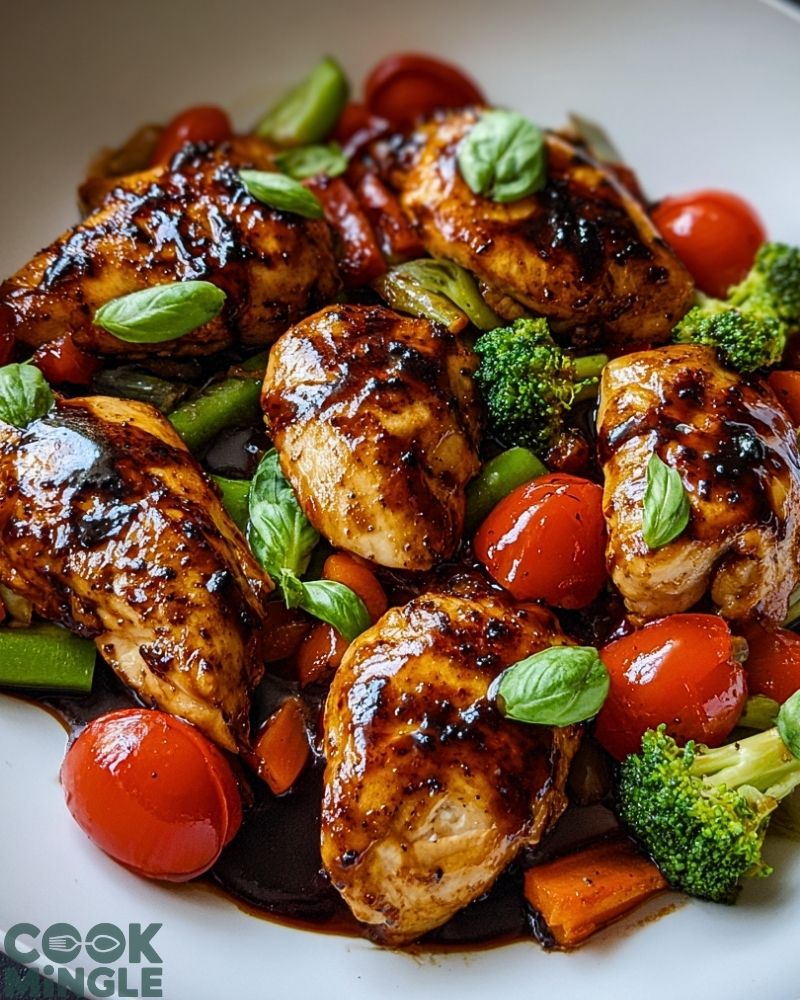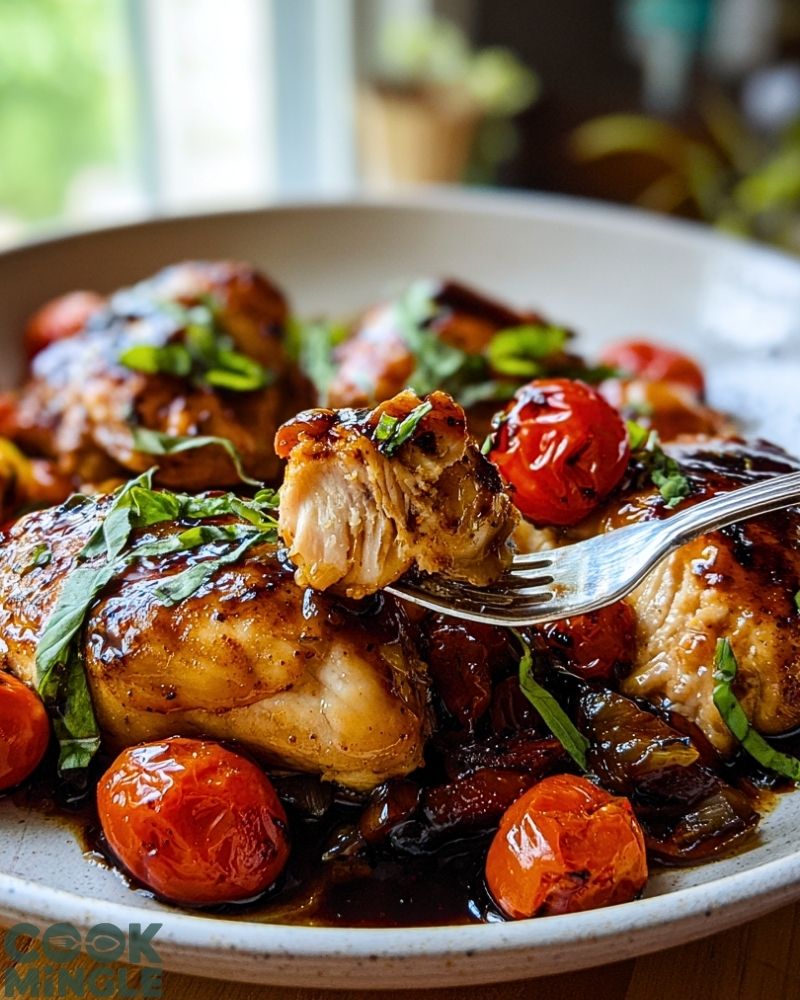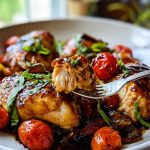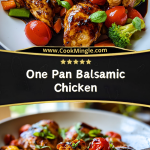When I’m in need of a comforting yet quick dinner that doesn’t leave a mountain of dishes behind, I always turn to my One Pan Balsamic Chicken. It’s the kind of meal that fills the kitchen with an irresistible aroma and comes together beautifully with just a handful of wholesome ingredients. Juicy chicken breasts are pan-seared to golden perfection, then simmered in a tangy-sweet balsamic glaze alongside vibrant vegetables and cherry tomatoes that burst with flavor.

What I love most about this dish is how effortlessly elegant it feels. Whether I’m cooking for my family on a weeknight or having guests over for a casual dinner, this recipe never fails to impress. The balance of savory, sweet, and acidic flavors makes every bite memorable—and it’s all done in one pan. That’s the kind of kitchen win I live for.
Why You’ll Love This One Pan Balsamic Chicken
- Minimal cleanup thanks to the one-pan approach
- Perfectly balanced flavor from the rich balsamic glaze
- Great for meal prep—it reheats beautifully
- Customizable veggies depending on what’s in season
- Healthy and satisfying, packed with lean protein and colorful vegetables
What Kind of Balsamic Vinegar Should I Use?
Not all balsamic vinegars are created equal, and for this One Pan Balsamic Chicken, the quality of your vinegar really makes a difference. I recommend using a thick, aged balsamic vinegar if you can find it—it brings a deeper, sweeter flavor and naturally reduces better in the pan. However, if you’re using a thinner, more acidic balsamic, don’t worry. You can still build amazing flavor by allowing it to reduce longer on the stove until it becomes syrupy and concentrated.
If your vinegar is very sharp or tangy, adding a touch more honey or maple syrup can help mellow things out. The key is balance—rich enough to coat the chicken, but not overly sweet.
Options for Substitutions
One of the great things about this dish is its flexibility. If you’re missing an ingredient or want to switch things up, here are a few tried-and-true substitutions:
- Chicken: Swap out boneless skinless chicken breasts for thighs if you prefer juicier, richer meat.
- Vegetables: Use whatever you have—zucchini, mushrooms, green beans, or even asparagus work wonderfully.
- Sweetener: If you’re out of honey, try maple syrup, brown sugar, or even a splash of orange juice.
- Herbs: Fresh basil is lovely, but parsley, thyme, or rosemary also pair beautifully with balsamic flavors.
- Balsamic glaze: If you don’t have balsamic vinegar, a premade balsamic glaze will work in a pinch—just skip the reduction step and adjust sweetness accordingly.
Ingredients for This One Pan Balsamic Chicken
Chicken breasts
They’re the heart of this dish—lean, protein-packed, and they soak up that balsamic glaze like a dream. I like to use boneless, skinless breasts for quicker cooking and easy slicing.
Balsamic vinegar
This is where the magic happens. It reduces into a glossy glaze that adds depth, tanginess, and a slight sweetness to every bite.
Honey
A touch of honey balances the acidity of the vinegar and gives the sauce that signature sticky texture. It also caramelizes beautifully in the pan.
Garlic
Fresh garlic adds bold, aromatic flavor that really wakes up the sauce. It’s essential for that savory backbone.
Cherry tomatoes
They add bursts of juiciness and sweetness. As they roast, they soften and intensify in flavor—like little flavor bombs.
Bell peppers
These bring crunch, color, and natural sweetness that complement the glaze perfectly. I like to use a mix of red and yellow for visual appeal.
Broccoli
A hearty veggie that holds up well to the heat. It soaks up the balsamic glaze and adds a satisfying texture to the dish.
Olive oil
Used for searing the chicken and sautéing the vegetables—it enhances flavor while keeping everything from sticking.
Salt and pepper
Simple but vital. They bring out all the other flavors and help season the chicken just right.
Fresh basil (optional)
Adds a fresh, herbal finish at the end that cuts through the richness and adds brightness.

Step 1: Sear the Chicken
Start by seasoning the chicken breasts generously with salt and pepper. Heat olive oil in a large skillet over medium-high heat. Once the oil is hot, add the chicken and sear for about 4–5 minutes per side, or until a golden crust forms. You don’t need to cook it all the way through at this point—just get that color and flavor going. Remove the chicken and set aside.
Step 2: Sauté the Vegetables
In the same pan (don’t wipe it out!), add a bit more olive oil if needed. Toss in the broccoli and bell peppers, and cook for about 5 minutes until they start to soften slightly. Add the cherry tomatoes and continue to sauté for another 3–4 minutes. The tomatoes should begin to blister and release some juice.
Step 3: Make the Balsamic Glaze
Push the vegetables to the edges of the pan to make space in the center. Add minced garlic and cook for about 30 seconds until fragrant. Pour in the balsamic vinegar and stir in the honey. Let it bubble for 2–3 minutes to reduce slightly and become glossy.
Step 4: Combine and Finish Cooking
Nestle the seared chicken breasts back into the pan, spooning the balsamic glaze over the top. Reduce the heat to medium-low and cover the pan. Let everything simmer for about 7–10 minutes, or until the chicken is fully cooked through and the vegetables are tender. Spoon more glaze over the chicken before serving.
How Long to Cook the One Pan Balsamic Chicken
The total cooking time for this dish is about 25 to 30 minutes. The chicken takes roughly 8–10 minutes to sear and an additional 7–10 minutes to finish cooking in the glaze. Vegetables cook in about 8–10 minutes, depending on how crisp or tender you like them.
Use a meat thermometer if you’re unsure—the chicken should reach an internal temperature of 165°F (74°C) in the thickest part.
Tips for Perfect One Pan Balsamic Chicken
- Pound your chicken breasts if they’re uneven in thickness. This helps them cook more evenly and avoids dry spots.
- Don’t overcrowd the pan when searing. Give each piece enough space for a proper golden crust.
- Let the glaze reduce properly. It should be slightly thickened, not watery—watch for a glossy, syrup-like consistency.
- Adjust sweetness to taste. Depending on your balsamic vinegar, you may want to add a touch more honey or reduce the amount slightly.
- Deglaze the pan with a splash of water or broth if it starts to dry out while cooking. This also lifts up all those flavorful bits.
- Garnish just before serving. Fresh basil or parsley adds color and freshness that makes the dish pop.
Watch Out for These Mistakes While Cooking
- Skipping the sear: It might be tempting to toss everything in the pan at once, but searing the chicken first builds deep flavor and keeps the texture spot-on.
- Using watery balsamic vinegar: Thin, low-quality balsamic can lead to a weak glaze. If that’s all you have, reduce it longer or add a thickener like a teaspoon of cornstarch mixed with water.
- Overcrowding the pan: This causes the chicken and veggies to steam instead of brown. Cook in batches if needed.
- Adding garlic too early: Garlic burns quickly. Always add it after the vegetables have softened or when there’s liquid to protect it.
- Overcooking the chicken: Dry chicken ruins the whole dish. Pull it off the heat as soon as it reaches 165°F.
What to Serve With One Pan Balsamic Chicken?
Roasted Potatoes
Crispy, herby potatoes pair wonderfully with the sweet tang of the balsamic glaze.
Garlic Mashed Cauliflower
A low-carb, creamy side that complements the bold flavors of the chicken.
Rice Pilaf
Fluffy and lightly seasoned, rice pilaf soaks up that glaze like a dream.
Crisp Green Salad
Keep it simple—mixed greens, cucumbers, and a light vinaigrette to balance the rich glaze.
Buttery Polenta
Soft and creamy polenta makes for a comforting base under the chicken and vegetables.
Crusty Bread
Perfect for mopping up every drop of that balsamic glaze.
Steamed Quinoa
A protein-rich, nutty option that fits well with the healthful vibe of the dish.
Grilled Asparagus
Adds a smoky, crisp contrast to the sweet-tangy main course.
Storage Instructions
One Pan Balsamic Chicken stores beautifully, making it great for leftovers or meal prep. Let everything cool completely before transferring to an airtight container.
- Refrigerator: Store in the fridge for up to 4 days. Reheat gently in a skillet over low heat or in the microwave with a splash of water to keep it moist.
- Freezer: You can freeze the chicken and glaze for up to 3 months. Store vegetables separately for best texture, as some may become mushy after thawing. Thaw overnight in the fridge before reheating.
Estimated Nutrition
This is a general estimate for one serving (based on 4 servings total):
- Calories: 360
- Protein: 35g
- Carbohydrates: 18g
- Sugars: 11g
- Fat: 15g
- Saturated Fat: 2g
- Fiber: 3g
- Sodium: 410mg
Nutrition may vary depending on the specific brands and amounts of ingredients you use.
Frequently Asked Questions
Can I use chicken thighs instead of breasts?
Absolutely! Chicken thighs are juicy and flavorful. Just adjust the cooking time slightly as they may take a bit longer to cook through.
What if my balsamic glaze is too sour?
Add a bit more honey or maple syrup to balance the acidity. Letting the glaze reduce longer also mellows out sharpness.
Can I make this dish ahead of time?
Yes, this dish reheats really well. Prepare everything, let it cool, and store it in the fridge. Reheat gently before serving.
Can I use frozen vegetables?
Frozen veggies work in a pinch, but they may release more water. Let them thaw and pat dry before cooking to avoid watering down the glaze.
Is this recipe gluten-free?
Yes, as long as your balsamic vinegar is gluten-free. Always double-check the label if you have gluten sensitivities.
How do I know when the chicken is done?
Use a meat thermometer. The internal temperature should reach 165°F (74°C). If you don’t have one, cut into the thickest part—juices should run clear.
Can I double the recipe?
Definitely, but use a larger skillet or two pans to avoid overcrowding, which affects browning and sauce reduction.
Can I add cheese to this dish?
A sprinkle of freshly grated Parmesan at the end can add a lovely savory touch. Goat cheese or feta also pair well.
Conclusion
One Pan Balsamic Chicken is everything I want in a go-to dinner—simple, flavorful, and satisfying. With minimal cleanup, flexible ingredients, and a crave-worthy glaze that ties everything together, it’s a staple in my weekly rotation. Whether you’re cooking for yourself or feeding a crowd, this dish delivers big flavor with ease. Once you try it, I’m betting it’ll earn a regular spot at your table too.

One Pan Balsamic Chicken
- Total Time: 30 minutes
- Yield: 4 servings
Description
One Pan Balsamic Chicken is a savory, tangy, and slightly sweet dish featuring juicy seared chicken breasts simmered in a rich balsamic glaze alongside vibrant vegetables like cherry tomatoes, broccoli, and bell peppers. It’s easy to make, packed with flavor, and leaves you with just one pan to clean.
Ingredients
- 4 boneless, skinless chicken breasts
- 1/2 cup balsamic vinegar
- 2 tablespoons honey
- 2 cloves garlic, minced
- 1 cup cherry tomatoes
- 1 red bell pepper, sliced
- 1 yellow bell pepper, sliced
- 1 1/2 cups broccoli florets
- 2 tablespoons olive oil
- Salt and pepper to taste
- Fresh basil for garnish (optional)
Instructions
- Season chicken breasts with salt and pepper.
- Heat 1 tablespoon olive oil in a large skillet over medium-high heat.
- Sear chicken breasts for 4–5 minutes per side until golden; remove and set aside.
- Add remaining olive oil to the same pan, then sauté broccoli and bell peppers for 5 minutes.
- Add cherry tomatoes and cook another 3–4 minutes until softened.
- Push veggies aside, add garlic, and cook for 30 seconds.
- Pour in balsamic vinegar and honey, stir, and let it reduce for 2–3 minutes.
- Return chicken to the pan, spoon glaze over the top, and cover.
- Simmer on medium-low heat for 7–10 minutes, or until chicken is cooked through.
- Garnish with fresh basil before serving.
- Prep Time: 10 minutes
- Cook Time: 20 minutes

